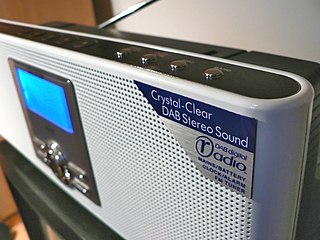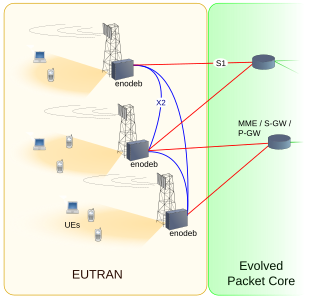
In computer networking, multicast is a type of group communication where data transmission is addressed to a group of destination computers simultaneously. Multicast can be one-to-many or many-to-many distribution. Multicast differs from physical layer point-to-multipoint communication.

In telecommunications, orthogonal frequency-division multiplexing (OFDM) is a type of digital transmission used in digital modulation for encoding digital (binary) data on multiple carrier frequencies. OFDM has developed into a popular scheme for wideband digital communication, used in applications such as digital television and audio broadcasting, DSL internet access, wireless networks, power line networks, and 4G/5G mobile communications.

A communication channel refers either to a physical transmission medium such as a wire, or to a logical connection over a multiplexed medium such as a radio channel in telecommunications and computer networking. A channel is used for information transfer of, for example, a digital bit stream, from one or several senders to one or several receivers. A channel has a certain capacity for transmitting information, often measured by its bandwidth in Hz or its data rate in bits per second.

Digital radio is the use of digital technology to transmit or receive across the radio spectrum. Digital transmission by radio waves includes digital broadcasting, and especially digital audio radio services.
4G is the fourth generation of broadband cellular network technology, succeeding 3G and preceding 5G. A 4G system must provide capabilities defined by ITU in IMT Advanced. Potential and current applications include amended mobile web access, IP telephony, gaming services, high-definition mobile TV, video conferencing, and 3D television.

A single-frequency network or SFN is a broadcast network where several transmitters simultaneously send the same signal over the same frequency channel.
DVB-H is one of three prevalent mobile TV formats. It is a technical specification for bringing broadcast services to mobile handsets. DVB-H was formally adopted as ETSI standard EN 302 304 in November 2004. The DVB-H specification can be downloaded from the official DVB-H website. For a few months from March 2008, DVB-H was officially endorsed by the European Union as the "preferred technology for terrestrial mobile broadcasting".

Orthogonal frequency-division multiple access (OFDMA) is a multi-user version of the popular orthogonal frequency-division multiplexing (OFDM) digital modulation scheme. Multiple access is achieved in OFDMA by assigning subsets of subcarriers to individual users. This allows simultaneous low-data-rate transmission from several users.
Multimedia Broadcast Multicast Services (MBMS) is a point-to-multipoint interface specification for existing 3GPP cellular networks, which is designed to provide efficient delivery of broadcast and multicast services, both within a cell as well as within the core network. For broadcast transmission across multiple cells, it defines transmission via single-frequency network configurations. The specification is referred to as Evolved Multimedia Broadcast Multicast Services (eMBMS) when transmissions are delivered through an LTE network. eMBMS is also known as LTE Broadcast.

E-UTRA is the air interface of 3rd Generation Partnership Project (3GPP) Long Term Evolution (LTE) upgrade path for mobile networks. It is an acronym for Evolved UMTS Terrestrial Radio Access, also known as the Evolved Universal Terrestrial Radio Access in early drafts of the 3GPP LTE specification. E-UTRAN is the combination of E-UTRA, user equipment (UE), and a Node B.
Mobile television is television watched on a small handheld or mobile device, typically developed for that purpose. It includes service delivered via mobile phone networks, received free-to-air via terrestrial television stations, or via satellite broadcast. Regular broadcast standards or special mobile TV transmission formats can be used. Additional features include downloading TV programs and podcasts from the Internet and storing programming for later viewing.
In the field of wireless communication, macrodiversity is a kind of space diversity scheme using several receiver or transmitter antennas for transferring the same signal. The distance between the transmitters is much longer than the wavelength, as opposed to microdiversity where the distance is in the order of or shorter than the wavelength.
Dynamic single-frequency networks (DSFN) is a technique of using several transmitter antennas to transfer the same signal (macrodiversity) in orthogonal frequency-division multiplexing cellular networks.
Radio resource management (RRM) is the system level management of co-channel interference, radio resources, and other radio transmission characteristics in wireless communication systems, for example cellular networks, wireless local area networks, wireless sensor systems, and radio broadcasting networks. RRM involves strategies and algorithms for controlling parameters such as transmit power, user allocation, beamforming, data rates, handover criteria, modulation scheme, error coding scheme, etc. The objective is to utilize the limited radio-frequency spectrum resources and radio network infrastructure as efficiently as possible.
DVB-SH is a physical layer standard for delivering IP based media content and data to handheld terminals such as mobile phones or PDAs, based on a hybrid satellite/terrestrial downlink and for example a GPRS uplink. The DVB Project published the DVB-SH standard in February 2007.
International Mobile Telecommunications-Advanced are the requirements issued by the ITU Radiocommunication Sector (ITU-R) of the International Telecommunication Union (ITU) in 2008 for what is marketed as 4G mobile phone and Internet access service.
Broadcast and Multicast Service (BCMCS) is an interface for providing broadcast and multicast services in 3GPP2 CDMA2000 mobile networks. BCMCS can be used to transfer light video and audio clips or other data to a large group of mobile subscribers in an efficient manner. To do so, BCMCS is a so-called point-to-multipoint service. This means that multiple users receive the same information using the same radio resources.
DVB-RCT provides a method by which the DVB-T platform can become a bi-directional, asymmetric data path using wireless between broadcasters and customers. DVB-T when completed with DVB-RCT can be used not only for interactive TV, but also for light IP telecommunication services. Without this method, various degrees of interactivity can be offered, without implying any return channel back from the user to the service provider: Data Carrousel or Electronic Programs Guides (EPG) are examples of such enhanced TV services which make use of “local interactivity”, without any return path from customer to provider. To implement interactive services having a closely coupled and real-time relationship with the TV programs, a low latency return channel technology is mandatory, and this is the goal of the DVB-RCT.
Integrated Mobile Broadcast (iMB) is a mobile wireless technology that enables broadcast of content at the cellular transmitter level, using the 3G or 4G licensed radio spectrum, and received on mobile terminals.
Scalable video multicast is a new wireless multicast technology. In scalable video multicast, the video program subscribers can view the program in accordance with their link conditions. The scalable video multicast has been employed by many standards, such as MBMS, MBS, and DVB-H.






